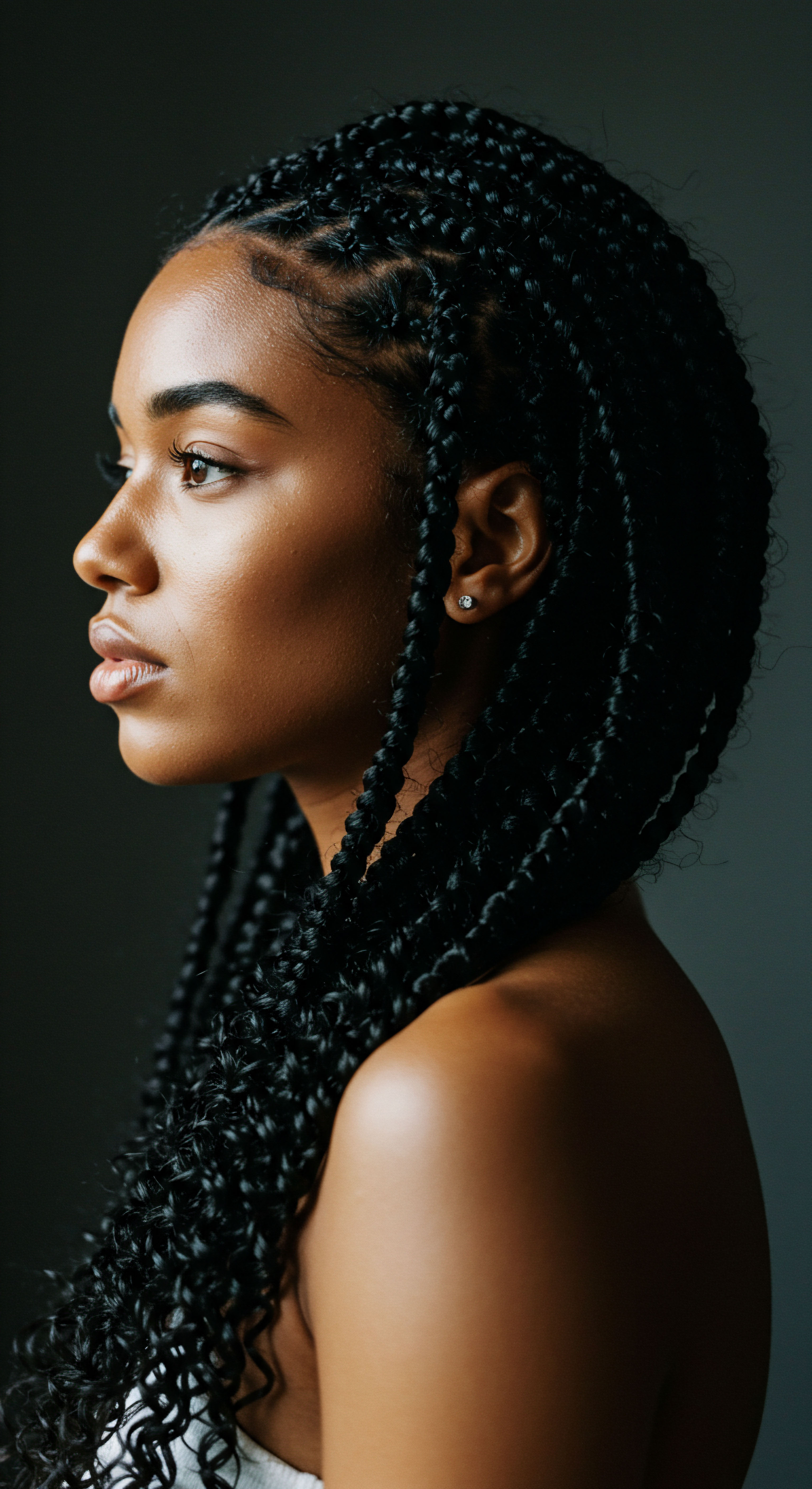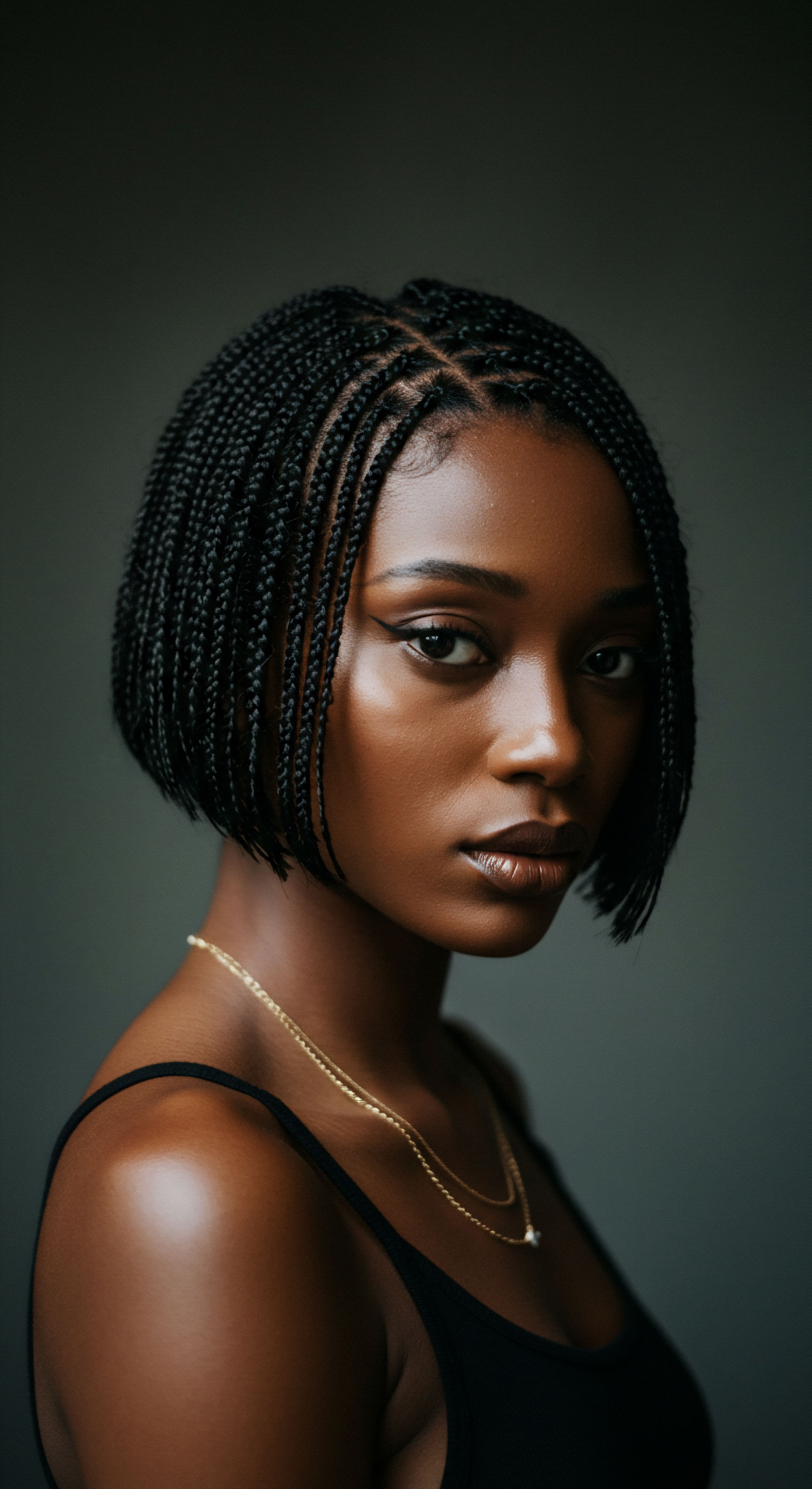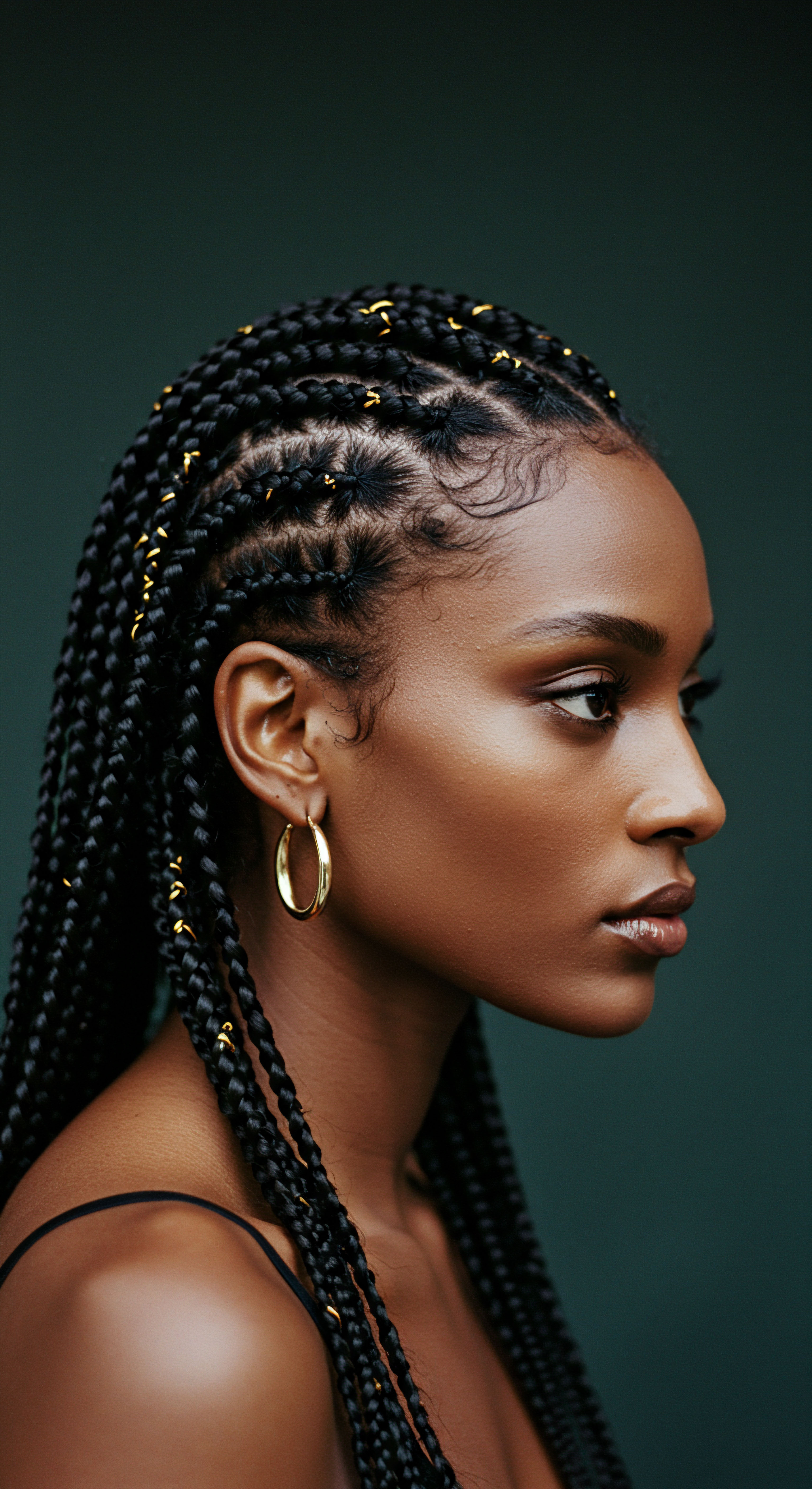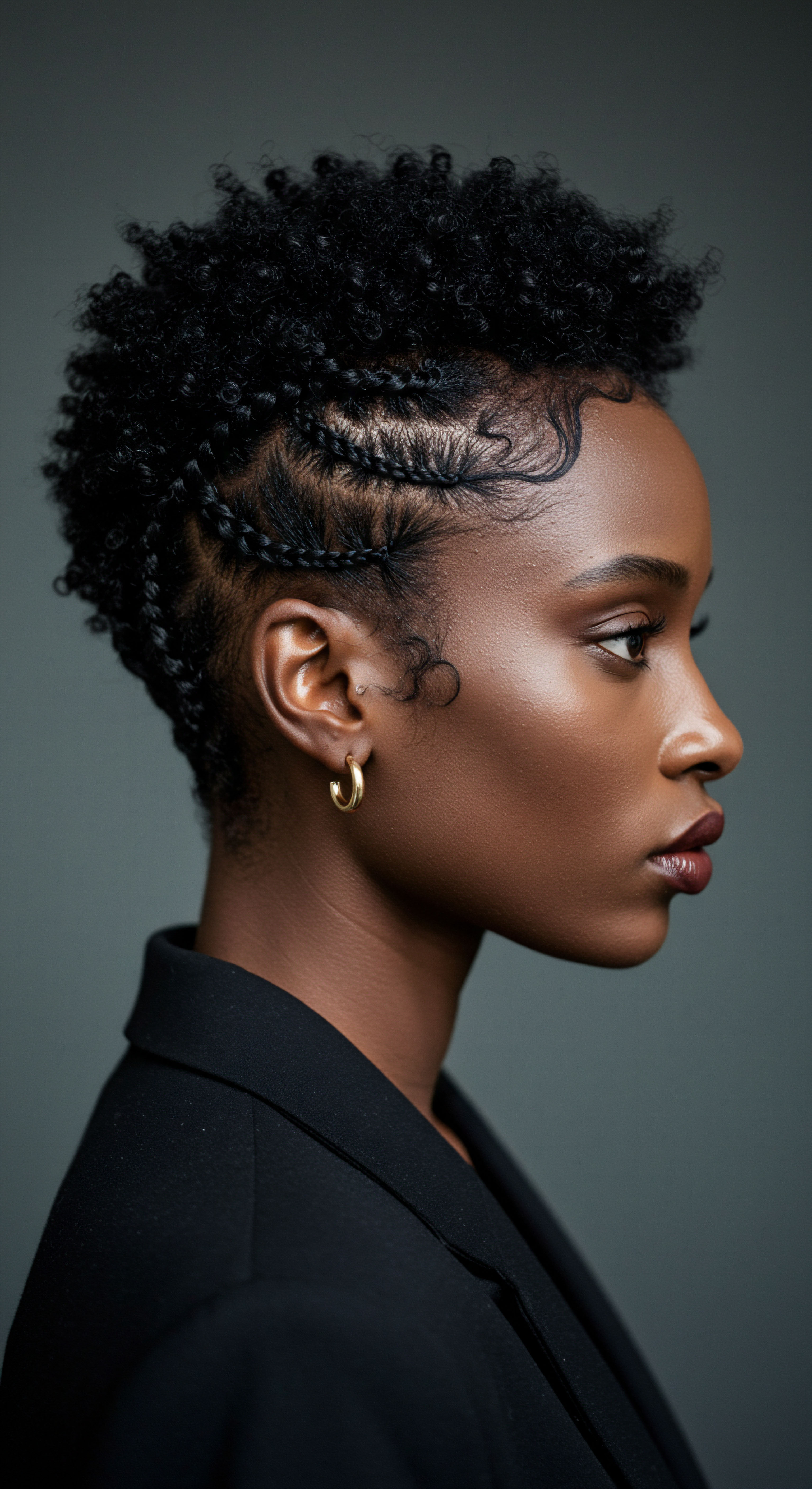
Roots
Consider the quiet hum of a deep, abiding connection, a resonance with practices that span generations, holding within them stories whispered across time. When we consider how enslaved women styled their hair, we step into a realm where every twist, every braid, every covering held layers of meaning far beyond mere adornment. Their hair, a vibrant extension of self, became a silent testament to resilience, a living chronicle etched onto the scalp and strands.
It was a canvas where cultural memory, personal identity, and an unyielding spirit found expression amidst dehumanizing conditions. To truly appreciate this, we must first lay a foundation, understanding the very nature of textured hair and its profound cultural significance in the lands from which these women were forcibly taken.
African hair, in its myriad forms, possesses a unique architecture. Unlike straight or wavy hair, its elliptical cross-section and often tight curl patterns contribute to its distinct strength and sometimes its vulnerability. The cuticle layers, while present, may lift more readily, making moisture retention a delicate balance.
The very structure, with its twists and turns along the shaft, allows for incredible versatility, enabling styles that defy gravity and hold intricate patterns. This inherent characteristic meant that African hair, even under duress, offered possibilities for styling that were both practical and deeply symbolic.
Before the transatlantic trade, hair care in African societies was a highly ritualized and communal activity. Hairstyles communicated age, marital status, tribal affiliation, social standing, and even religious beliefs. Hair was seen as a spiritual conduit, residing closest to the divine. Specialized tools, crafted from wood, bone, or horn, were employed with skill passed down through familial lines.
Natural emollients, like shea butter, palm oil, and various plant extracts, provided nourishment and sheen, reflecting a deep, indigenous knowledge of botanicals. These practices were not simply about cleanliness; they were integral to social cohesion and individual dignity.
Hair practices for enslaved women transcended simple aesthetics, becoming a powerful expression of identity and a silent form of communication.
The disruption of enslavement violently severed these women from their traditional resources and communities. The journey across the ocean, often under horrific conditions, meant a stripping away of identity, including the meticulous care of their hair. Yet, even in the brutal new world, the innate characteristics of their hair and the deep-seated cultural memory of its significance persisted. They adapted, improvising with whatever limited resources were available on plantations, often making do with coarse fabrics for head coverings or rudimentary tools fashioned from discarded materials.

What Challenges Did Textured Hair Present in Captivity?
The environmental realities of plantation life presented immense challenges for maintaining hair health. Field labor exposed hair to harsh sun, dust, and drying winds, while the scarcity of clean water and proper cleansing agents led to accumulation and breakage. The demanding schedules left little time for the elaborate, communal grooming sessions that were customary in their homelands.
This shift from abundant, culturally specific resources to meager, improvised means speaks volumes about the resourcefulness and determination of these women. They continued to seek ways to tend to their hair, understanding that even in degradation, a connection to self and heritage could be maintained through these small, yet profound, acts.
- Hair Anatomy ❉ The unique coiled structure of African hair, with its elliptical cross-section, offers both strength and susceptibility to dryness, requiring specific care.
- Pre-Colonial Significance ❉ Hair in African societies communicated social status, tribal identity, and spiritual connection, acting as a profound cultural marker.
- Resourcefulness ❉ Enslaved women adapted their hair care, utilizing limited available materials to maintain a connection to their heritage despite harsh conditions.
| Characteristic Length and Volume |
| Common Cultural Associations Signified prosperity, vitality, and health. |
| Characteristic Cleanliness and Luster |
| Common Cultural Associations Reflected social standing, personal hygiene, and spiritual purity. |
| Characteristic Specific Braiding Patterns |
| Common Cultural Associations Communicated marital status, age, tribal lineage, or community role. |
| Characteristic Adornments (beads, cowrie shells) |
| Common Cultural Associations Indicated wealth, protection, or ceremonial participation. |
| Characteristic Hair served as a visual language, speaking volumes about an individual's place and story within their community. |

Ritual
Stepping from the foundational understanding of textured hair, we now turn our gaze to the daily and weekly practices that shaped the lives of enslaved women. Their hair styling was not merely a reaction to circumstance; it was a purposeful application of ingenuity and cultural memory, transforming the mundane into acts of quiet defiance and communal support. The techniques they employed, often under the cloak of night or in fleeting moments of respite, reveal a practical wisdom honed by extreme necessity. These rituals, though stripped of their original grandeur, became vital threads connecting them to their ancestral traditions and to one another.
Protective styling became paramount. The harsh realities of field labor, with its exposure to sun, dirt, and demanding physical exertion, necessitated styles that would keep hair tidy, minimize breakage, and protect the scalp. Braids, particularly those close to the scalp, such as cornrows (often called ‘canerows’ in the Caribbean), were common.
These styles offered longevity, reducing the need for daily manipulation, which was a luxury they could not afford. The precision required for these styles, even when performed with rudimentary tools or bare hands, speaks to an inherited skill and an understanding of hair’s delicate nature.
The materials available were scarce and often crude. Animal fats, bacon grease, or even kerosene might have been used as emollients or cleansers, not for their beneficial properties, but simply for their availability and ability to lubricate or clean in some fashion. Head coverings, fashioned from scraps of cloth or discarded fabrics, served multiple purposes ❉ protection from the elements, concealment of hair that might not meet Eurocentric standards of “tidiness,” and a subtle expression of personal style or group affiliation. These headwraps, in their folds and ties, carried echoes of elaborate African head coverings, a silent language of identity persevering through suppression.
Despite brutal conditions, enslaved women maintained hair care practices, adapting techniques and materials to preserve identity and cultural connection.
Beyond the practical, these styling sessions often held a deeper communal significance. Sundays, often a brief reprieve from labor, became a time when women gathered to tend to one another’s hair. This communal grooming fostered bonds, allowed for the exchange of news and stories, and provided a moment of shared humanity.
In these intimate settings, hair care transcended its physical function, becoming a psychological refuge, a space for solidarity and emotional sustenance. It was a time when the hands working on hair offered comfort, shared grief, and quiet strength.

How Did Enslaved Women Adapt Their Hair Care Tools?
The ingenuity displayed in creating tools was extraordinary. Combs, essential for detangling and styling, were often fashioned from wood, bone, or even salvaged metal scraps. These handmade implements, though simple, allowed for the manipulation of tightly coiled hair, preventing tangles and aiding in the creation of styles.
The ability to create these tools from nothing underscores a deep practical knowledge and an unyielding commitment to personal grooming, even when the dominant society sought to strip away every vestige of self-worth. This resourcefulness highlights a persistent will to maintain dignity and a connection to ancestral practices.
The styles themselves, while often simple and utilitarian, were not devoid of aesthetic considerations. Braids, twists, and wrapped styles could be arranged with an eye for pattern and form. Even when covered, the underlying structure provided a sense of order and care.
The choice to maintain any form of styling, rather than simply letting hair remain unkempt, speaks to an internal drive for self-preservation and a refusal to fully succumb to the dehumanizing forces of their existence. It was a silent declaration of self, a small assertion of agency in a world that denied them nearly all control.
- Braiding Techniques ❉ Cornrows and various plaits were favored for their protective qualities and ability to withstand demanding physical labor.
- Improvised Products ❉ Women used animal fats, bacon grease, and even kerosene to lubricate and clean hair due to the absence of traditional African emollients.
- Communal Grooming ❉ Hair styling sessions, often on Sundays, became vital spaces for social connection, shared solace, and cultural continuity.
| Resource Animal Fats (e.g. bacon grease) |
| Purpose Lubrication, adding a semblance of moisture. |
| Resource Scraps of Cloth |
| Purpose Head coverings for protection, tidiness, and cultural expression. |
| Resource Hand-Carved Combs/Picks |
| Purpose Detangling, parting, and shaping hair. |
| Resource Lye Soap (harsh, but available) |
| Purpose Cleansing, though often damaging to hair and scalp. |
| Resource The resourcefulness in adapting available materials speaks to an enduring commitment to hair care. |

Relay
Our consideration now deepens, moving beyond the visible acts of styling to the profound layers of meaning and survival strategies embedded within enslaved women’s hair practices. This arena reveals not only the enduring spirit but also the intricate ways in which cultural expression became a form of resistance, a silent language spoken through texture and pattern. The very act of tending to one’s hair, under such oppressive conditions, was a refusal to be entirely stripped of self. It speaks to a profound understanding of identity as something internal, something that could be maintained even when external circumstances sought to erase it.
The devaluation of African physical characteristics, including tightly coiled hair, was a deliberate tool of subjugation. Slaveholders often referred to African hair as “wool,” a derogatory term intended to dehumanize and liken individuals to livestock. This systematic denigration aimed to erode self-worth and sever ties to African heritage.
Yet, within this climate of enforced inferiority, hair became a site of quiet, yet powerful, subversion. Women, often forced to shave their heads upon arrival or keep their hair covered for “tidiness,” found clandestine ways to reclaim their crowning glory.
Perhaps one of the most compelling aspects of hair styling among enslaved women was its covert use as a means of communication and escape. Historical accounts, particularly from Colombia, point to instances where cornrows served as literal maps to freedom. Benkos Biohó, an escaped royal from the Bissagos Islands, established a maroon village in Northern Colombia and reportedly utilized women’s cornrows to convey coded messages and escape routes. Specific patterns might indicate paths through swamps or mountains, or where to find water sources.
Even more remarkably, women sometimes hid seeds or gold fragments within their braids, carrying sustenance or potential currency for their perilous journeys to freedom. This subtle yet vital communication system underscores the incredible ingenuity and collective determination that defined resistance.
Hair served as a secret language, a map to freedom, and a vessel for sustenance, illustrating profound acts of defiance.
This hidden use of hair extends beyond mere escape. It speaks to the psychological burden of being denied one’s inherent beauty. Academic studies and historical analyses highlight how the imposition of Eurocentric beauty standards created a hierarchy, where lighter skin and straighter hair were often privileged, granting access to less physically demanding labor or even slightly better treatment. One could consider the observation by Banks (2000) that practices of hair alteration, even after emancipation, were often misconstrued as self-hatred, when they could also represent a complex attempt to assimilate for survival or economic opportunity.
This reveals the deeply ingrained psychological impact of slavery, where the appearance of hair could directly correlate with one’s perceived value and even safety. The very texture of African hair, deemed “unkempt” or “unprofessional” by the dominant society, became a symbol of racial difference to be suppressed.

Did Hair Practices Reflect Social Status Among Enslaved Women?
While the rigid hierarchy of enslavement largely dictated social standing, subtle distinctions could still manifest through hair. House slaves, for instance, sometimes had access to slightly better resources or were required to maintain a more “presentable” appearance for their enslavers, which might involve attempts to straighten hair using hot combs or crude lye-based concoctions. This was not a choice of preference but a mandate of survival, a coerced conformity that still carried the echoes of an earlier, imposed standard.
Conversely, field slaves, with less time and resources, often wore more utilitarian styles, like tightly braided cornrows or simple wraps, for practical reasons of protection and maintenance. This practical divergence, while rooted in oppressive conditions, still created a visual language of roles and experiences within the enslaved community.
The legacy of these practices continues to shape contemporary discussions around textured hair. The persistent societal pressures to conform to Eurocentric beauty norms, often reflected in the workplace or public spaces, bear a direct lineage to the historical devaluation of African hair during slavery. The very concept of “good hair” versus “bad hair” within some communities is a painful echo of the hierarchy imposed by slaveholders. Understanding this deep historical context allows us to view contemporary hair choices with greater empathy and awareness, recognizing them as responses to centuries of ingrained prejudice.
- Covert Communication ❉ Cornrows were reportedly used as maps or to hide seeds for escape, illustrating a sophisticated system of resistance.
- Psychological Impact ❉ The denigration of African hair as “wool” by enslavers contributed to a lasting societal bias and internal struggle over hair identity.
- Survival Adaptations ❉ Hair practices sometimes reflected a coerced conformity to Eurocentric standards, especially for house slaves, to navigate the brutal social hierarchy.
| Aspect of Hair Braiding Patterns |
| Function in Enslavement Coded messages, escape route maps. |
| Aspect of Hair Hidden Items |
| Function in Enslavement Carrying seeds or gold for survival during escape. |
| Aspect of Hair Maintenance/Styling |
| Function in Enslavement Preservation of cultural identity, quiet defiance against dehumanization. |
| Aspect of Hair Head Coverings |
| Function in Enslavement Protection, concealment, and subtle cultural expression. |
| Aspect of Hair The deliberate manipulation of hair became a testament to the enduring spirit of enslaved women. |

Reflection
As we step back from the intricate world of enslaved women’s hair practices, a profound realization settles upon us ❉ the stories held within each coil, each braid, and each head covering are not merely historical footnotes. They are vibrant echoes of resilience, ingenuity, and an unwavering spirit that refused to be extinguished. The methods and meanings these women applied to their hair, under unimaginable duress, offer us a deeper appreciation for the enduring power of cultural identity and the human capacity for resistance.
It reminds us that beauty, self-expression, and connection can persevere even in the face of the most brutal attempts at dehumanization. Their hair, then and now, remains a testament to survival, a quiet monument to those who carried their heritage with grace and fortitude.

References
- Banks, Ingrid. Hair Matters ❉ Beauty, Power, and Black Women’s Consciousness. New York University Press, 2000.
- Byrd, Ayana D. and Lori L. Tharps. Hair Story ❉ Untangling the Roots of Black Hair in America. St. Martin’s Press, 2001.
- Lawson, Brenda M. “Black Hair ❉ The Historical and Cultural Significance.” Journal of Black Studies, vol. 28, no. 6, 1998, pp. 751-762.
- Patton, Tracey Owens. “Black Hair ❉ A History of Race, Beauty, and Resistance.” The Journal of American Culture, vol. 33, no. 1, 2010, pp. 4-13.
- Thompson, Cheryl. “Black Women and Identity ❉ The Politics of Hair.” Women’s Studies International Forum, vol. 32, no. 5, 2009, pp. 343-352.
- White, Shane, and Graham White. Stylin’ ❉ African American Expressive Culture from Its Beginnings to the Zoot Suit. Cornell University Press, 1995.
- Sieber, Roy, and Frank Herreman. Hair in African Art and Culture. The Museum for African Art, 2000.